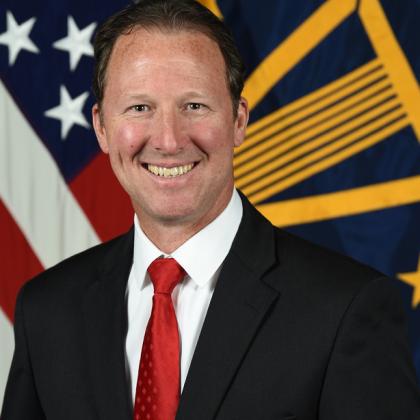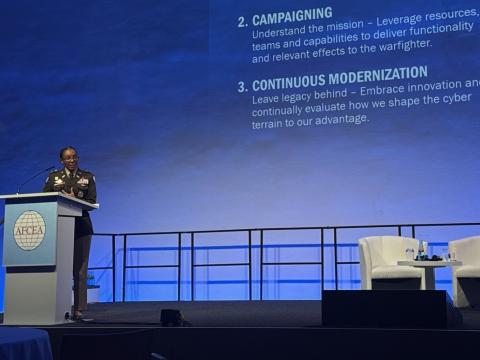DoD Aims To Upend Cyber Hiring
As they begin implementing the cyber workforce strategy, U.S. Defense Department officials are open to changes that could fundamentally alter hiring practices in the cyber arena.
Mark Gorak, principal director for resources and analysis in the department’s office of the chief information officer, said in a recent interview that the department plans a large “pilot” program designed to revise hiring processes and expand the cyber workforce. One goal will be to provide a more positive process for job seekers.
Among changes, the department intends to open its doors to neurodivergent workers. “We must fundamentally now change the way we hire, because in our traditional hiring processes, I can't easily hire that population. One of our initiatives is to change the hiring process and turn it kind of upside down. And I'm going to be doing a pilot in the first or second quarter if we get a budget soon,” Gorak told SIGNAL Media during an at TechNet Indo-Pacific in Honolulu.
“The big pilot program that we'll be executing here is—I hesitate to call it a hiring pilot, but in effect, that's what it is—we want to fundamentally change our focus on hiring through three aspects of that program. First, the focus has to be on the candidate. The candidate is the most important part of the hiring process. Mentorship, care and feeding human-to-human communication with the candidates is critical. Our current system does not do that,” he stated.
Instead, the current system is “post-and-pray,” meaning the department posts a job and prays qualified candidates respond. “Our pilot program works with third-party vendors to go after diversity. I have vendors that specialize just in neurodivergent [personnel]. I have vendors that specialize just in military retirees or military transitioning. I have vendors that specialize just in military spouses,” Gorak reported. “There’s tons of vendors out there, and I call them partners and vendors because they're not all industry. There's a lot of nonprofits and there's a lot of people who just want to help these specialized communities. I want to partner with them to build a, if you will, a database of quality applicants.”
The department provides the vendors with the knowledge, skills, abilities and tasks required for cyber positions, and those vendors compete to provide lists of qualified candidates. The lists are then shared so that the military services and components can pick and choose who to interview. “I want to establish competition for the hiring managers: first come, first serve. Here’s a list of qualified applicants. Here are their resumes, here's all the information about them, and that's all through an enterprise talent management system that we have developed,” Gorak offered. “And then they pick. And if they don’t pick quickly enough … they lose out potentially on their first choice.”
The system includes a “feedback loop” that shows how many hiring managers are interested in a particular individual, which may prompt others to look at the person’s qualifications. “Maybe I want to quickly get their resume and do a 15-minute interview and offer them a position today. I also have mentors for each of the candidates so if they don't get selected for a position, I want to provide feedback to them on why they didn’t get selected. You can’t do that today in the system. It doesn’t exist, so I think this is an outstanding opportunity.”
Department officials hope to hire about 1,000 new workers within three months of starting the pilot, Gorak revealed, acknowledging the goal is aspirational but noting that the department could hire hundreds of candidates simultaneously, borrowing best practices from industry. “I'm not doing anything new. It's relatively new to federal service. I don't know if it's going to work. I really don’t. But I think it’ll be really fun trying and taking care of the candidate with that focus.”

I’m not here to break the law, but I want to bend it. I really do.
Artificial intelligence (AI) may play a role in the process. “I want to use AI to do all the repetitive tasks like qualification and all the Title Five requirements and then have the hiring managers, and the human resources community focus specifically on the applicant and what their needs are. That's the fundamental shift to what we are trying to do there,” he said.
While getting the resources for a “new start” program is the most daunting hurdle, changing the hiring culture is second, Gorak indicated. For every one of the several “forward-thinking” human resources personnel who are “ready to go,” five or six will assert that some desired changes are not possible, he said. “They have a checklist of all these requirements that we have to abide by. And that's great. I'm not here to break the law, but I want to bend it. I really do. But they’re going to tell me what is bending and what is breaking.”
As part of shifting the cultural mindset, Gorak works with the Office of Personnel Management and the Office of Management and Budget. “It’s a fundamentally different way of thinking about hiring for the federal government, so lots of hurdles to overcome. That's why I call it a pilot because I can get away with a little bit more on a pilot,” he said.
Ultimately, however, the changes will need to be scaled beyond the pilot. “If I am successful at the pilot, but it can’t scale, then I won’t continue. It might be a great pilot and it can hire 1,000 people, but I need 30,000 people,” he said.
Data will determine which changes become permanent. “I challenge the team to be bold and try new things, and then we’ll measure through data. To me, data is the foundation for all of this, so we use a [Office of the Secretary of Defense] platform called Advana, and I measure all of these things. I measure retention, I measure recruitment, I measure identification and proficiency levels and training.”






Comments